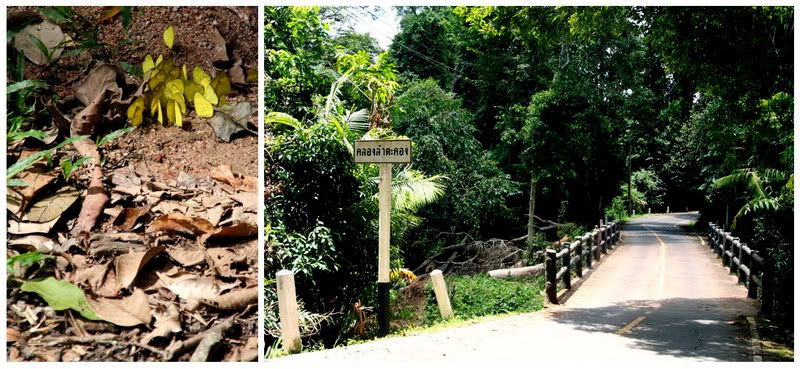
Leaving Bangkok last Sunday, Bordeaux and I headed north by train to Pak Chong, frontier town to Khao Yai National Park. After spending a night just of outside town, we took a public songthew to the Khao Yai park gate. There, we sat among our backpacks, and waited for a car to give us a lift in. The ranger at the gate kindly asked the driver of a pick-up for us; he nodded, so we hopped into the back of his truck. The journey into Khao Yai gave us a sense of what we'd see inside the park- unimaginably lush green towering forest, rising sharply from the edge of the asphalt road. The forest was beautiful and darkly mysterious, vines and stranglers swallowing tree-trunks and tangling into knots as they pushed up vertically. I had wanted to see the jungles of Southeast Asia for years, and this first taste didn't satisfy, but rather only managed to make me more intrigued and curious. Even the sudden downpour of steamy tropical rain couldn't distract me from studying the forest- I just pulled my cap lower, and held onto the truck tighter as I watched the green tangles enveloping me.
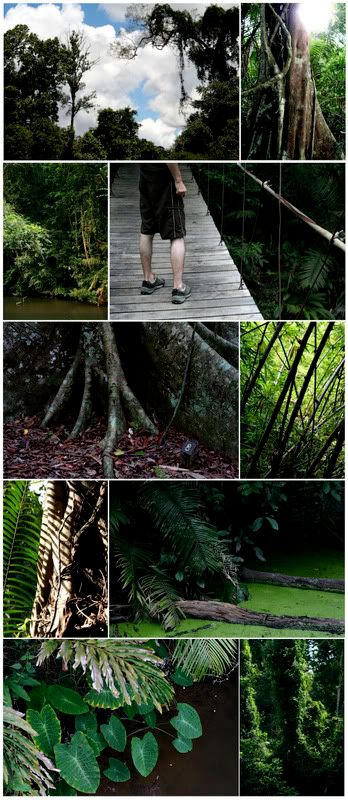
I've always been fascinated with jungles. They were not only the home of my favorite beasts, but in some way they represented all the darkness and danger and strangeness of the exotic world. So I was rather disappointed when I first traveled in Central America, and found that my photographs of jungles came out so poorly. As I found out, jungles aren't easy places to photograph. There are of course technical reasons for this, mainly the lack of light. There are also practical aspects that make it difficult for a photographer- the heat and sweat, and, on this trop, the constant battle against ground leeches climbing up my shoe. But there are other reasons, as well. To begin with, the forest is often just a mess of green, with few other colors standing out, so framing an interesting composition can be difficult. One option is to search for focal points- animals or flowers or landmarks- around which to structure a picture. But this rarely makes for an interesting photograph- the images come out like scientific stills of singular objects against a background of green. It's perhaps exactly because jungle have an aura of mystery that they're very difficult places to photograph. How do you capture the unknown forest though a medium that was developed to illuminate and illustrate? In the end, my decision was simply to stop trying to order my compositions. Instead, I tried to capture the disorder of the jungle through less planned out and framed shots. In the end, any order that resulted would be the forest's own, emerging in the lines of bamboo or the patterns of leaves.
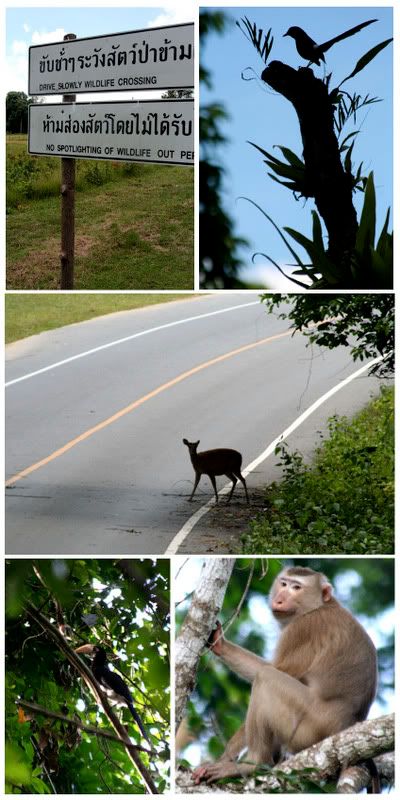
Photographing wildlife was just as difficult. We had come to Khao Yai expecting not to see much wildlife, but ended up being very lucky. Despite the number of incredible, strange creatures we saw, few sightings resulted in good photographs. The barking deer would dart into the forest if approached, flycatchers rarely waited in appropriate light, and macaques refused to sit still. While searching for our campsite on our first day at Khao Yai, Bordeaux and I were surrounded by the slow deep song of the gibbon. We stopped to listen, and noticed the movement of leaves in the trees nearby. Searching in the shadowy gaps between trees, we saw the silhouette of several gibbons swinging among branches. They were too quick and in too dark of forest to photograph, but the sight was beautiful- their strange, long arms swinging their bodies from one branch to another.
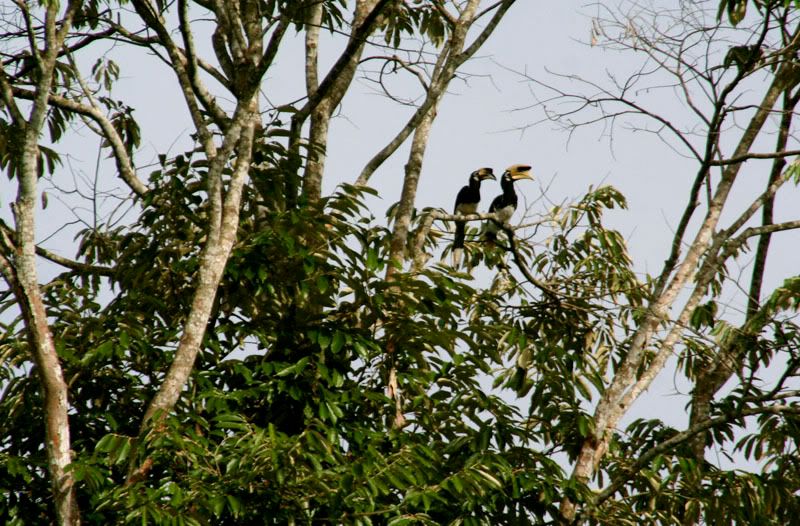
Just as beautiful and difficult to photograph were the park's hornbills. They're not shy birds- they chatter and fight noisily, jump around clumsily on branches, and flap loudly from one tree to another. But they roost so high that even with a zoom lens it's hard to get a very careful shot of them. We saw several pairs of Oriental Pied Hornbills, large black and white birds that fight incessantly in pairs. We watched them follow eachother around, flying from the height of one tree to the next. While crossing a bog one afternoon, we heard the loud flapping of wings overhead, and watched as a Great Hornbill passed over us, golden feathers flashing. It perched briefly on a distant tree, it's huge yellow casque shining brilliant, before taking off again.
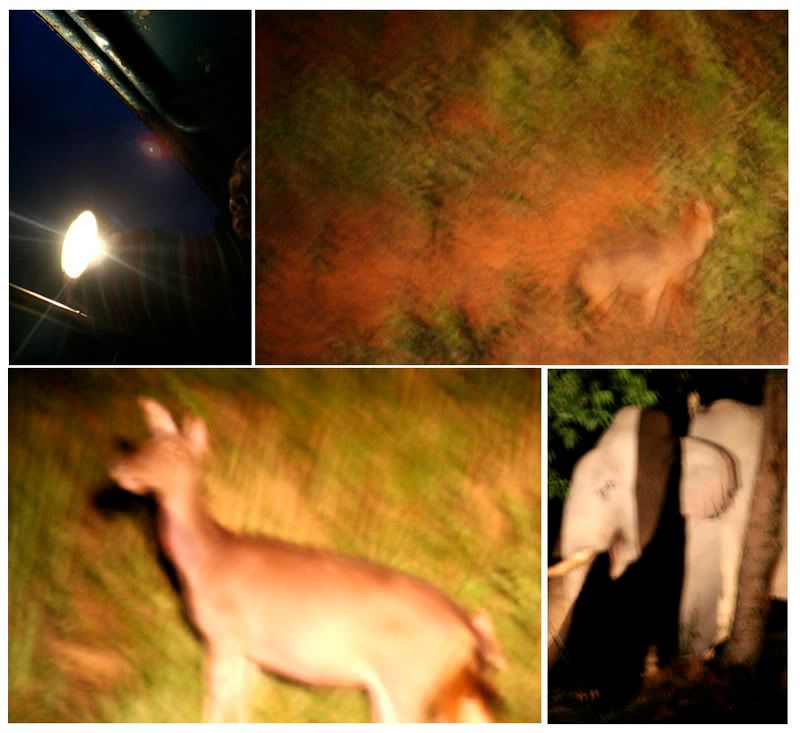
The greatest opportunity for seeing wildlife, the night lighting, was also the worst for photography. For 40 baht (about one dollar), you sit with five or ten other people in the back of a moving truck, watching as a guide flashes a spotlight around the jungle. It was awesome. The jungle is beautiful at night, even more obscure and elusive than in the day, with just the nearest leaves and tree-trunks emerging from darkness as we passed through. We saw an incredible number of animals on the first night drive- sambar and barking deer out grazing, civets enjoying a late meal, and a dhole (Asian wild dog) hiding among the grasses. When we returned to our camp from the first night drive, their was a Malayan porcupine waiting for us. As we moved toward our tent it walked past us, foot-long quills swaying. We were also lucky enough to have two elephant sightings, neither of which produced a good photograph. On the second night we saw a young bull elephant that was apparently angered by the light from our truck- it charged at us, so we quickly sped off without taking any photos. The other elephant was peacefully browsing, but as we stopped behind it, it put down its trunk and slipped into the forest, disappearing between vines and branches more effectively than one would think any elephant could.

 Leaving Bangkok last Sunday, Bordeaux and I headed north by train to Pak Chong, frontier town to Khao Yai National Park. After spending a night just of outside town, we took a public songthew to the Khao Yai park gate. There, we sat among our backpacks, and waited for a car to give us a lift in. The ranger at the gate kindly asked the driver of a pick-up for us; he nodded, so we hopped into the back of his truck. The journey into Khao Yai gave us a sense of what we'd see inside the park- unimaginably lush green towering forest, rising sharply from the edge of the asphalt road. The forest was beautiful and darkly mysterious, vines and stranglers swallowing tree-trunks and tangling into knots as they pushed up vertically. I had wanted to see the jungles of Southeast Asia for years, and this first taste didn't satisfy, but rather only managed to make me more intrigued and curious. Even the sudden downpour of steamy tropical rain couldn't distract me from studying the forest- I just pulled my cap lower, and held onto the truck tighter as I watched the green tangles enveloping me.
Leaving Bangkok last Sunday, Bordeaux and I headed north by train to Pak Chong, frontier town to Khao Yai National Park. After spending a night just of outside town, we took a public songthew to the Khao Yai park gate. There, we sat among our backpacks, and waited for a car to give us a lift in. The ranger at the gate kindly asked the driver of a pick-up for us; he nodded, so we hopped into the back of his truck. The journey into Khao Yai gave us a sense of what we'd see inside the park- unimaginably lush green towering forest, rising sharply from the edge of the asphalt road. The forest was beautiful and darkly mysterious, vines and stranglers swallowing tree-trunks and tangling into knots as they pushed up vertically. I had wanted to see the jungles of Southeast Asia for years, and this first taste didn't satisfy, but rather only managed to make me more intrigued and curious. Even the sudden downpour of steamy tropical rain couldn't distract me from studying the forest- I just pulled my cap lower, and held onto the truck tighter as I watched the green tangles enveloping me. I've always been fascinated with jungles. They were not only the home of my favorite beasts, but in some way they represented all the darkness and danger and strangeness of the exotic world. So I was rather disappointed when I first traveled in Central America, and found that my photographs of jungles came out so poorly. As I found out, jungles aren't easy places to photograph. There are of course technical reasons for this, mainly the lack of light. There are also practical aspects that make it difficult for a photographer- the heat and sweat, and, on this trop, the constant battle against ground leeches climbing up my shoe. But there are other reasons, as well. To begin with, the forest is often just a mess of green, with few other colors standing out, so framing an interesting composition can be difficult. One option is to search for focal points- animals or flowers or landmarks- around which to structure a picture. But this rarely makes for an interesting photograph- the images come out like scientific stills of singular objects against a background of green. It's perhaps exactly because jungle have an aura of mystery that they're very difficult places to photograph. How do you capture the unknown forest though a medium that was developed to illuminate and illustrate? In the end, my decision was simply to stop trying to order my compositions. Instead, I tried to capture the disorder of the jungle through less planned out and framed shots. In the end, any order that resulted would be the forest's own, emerging in the lines of bamboo or the patterns of leaves.
I've always been fascinated with jungles. They were not only the home of my favorite beasts, but in some way they represented all the darkness and danger and strangeness of the exotic world. So I was rather disappointed when I first traveled in Central America, and found that my photographs of jungles came out so poorly. As I found out, jungles aren't easy places to photograph. There are of course technical reasons for this, mainly the lack of light. There are also practical aspects that make it difficult for a photographer- the heat and sweat, and, on this trop, the constant battle against ground leeches climbing up my shoe. But there are other reasons, as well. To begin with, the forest is often just a mess of green, with few other colors standing out, so framing an interesting composition can be difficult. One option is to search for focal points- animals or flowers or landmarks- around which to structure a picture. But this rarely makes for an interesting photograph- the images come out like scientific stills of singular objects against a background of green. It's perhaps exactly because jungle have an aura of mystery that they're very difficult places to photograph. How do you capture the unknown forest though a medium that was developed to illuminate and illustrate? In the end, my decision was simply to stop trying to order my compositions. Instead, I tried to capture the disorder of the jungle through less planned out and framed shots. In the end, any order that resulted would be the forest's own, emerging in the lines of bamboo or the patterns of leaves. Photographing wildlife was just as difficult. We had come to Khao Yai expecting not to see much wildlife, but ended up being very lucky. Despite the number of incredible, strange creatures we saw, few sightings resulted in good photographs. The barking deer would dart into the forest if approached, flycatchers rarely waited in appropriate light, and macaques refused to sit still. While searching for our campsite on our first day at Khao Yai, Bordeaux and I were surrounded by the slow deep song of the gibbon. We stopped to listen, and noticed the movement of leaves in the trees nearby. Searching in the shadowy gaps between trees, we saw the silhouette of several gibbons swinging among branches. They were too quick and in too dark of forest to photograph, but the sight was beautiful- their strange, long arms swinging their bodies from one branch to another.
Photographing wildlife was just as difficult. We had come to Khao Yai expecting not to see much wildlife, but ended up being very lucky. Despite the number of incredible, strange creatures we saw, few sightings resulted in good photographs. The barking deer would dart into the forest if approached, flycatchers rarely waited in appropriate light, and macaques refused to sit still. While searching for our campsite on our first day at Khao Yai, Bordeaux and I were surrounded by the slow deep song of the gibbon. We stopped to listen, and noticed the movement of leaves in the trees nearby. Searching in the shadowy gaps between trees, we saw the silhouette of several gibbons swinging among branches. They were too quick and in too dark of forest to photograph, but the sight was beautiful- their strange, long arms swinging their bodies from one branch to another.  Just as beautiful and difficult to photograph were the park's hornbills. They're not shy birds- they chatter and fight noisily, jump around clumsily on branches, and flap loudly from one tree to another. But they roost so high that even with a zoom lens it's hard to get a very careful shot of them. We saw several pairs of Oriental Pied Hornbills, large black and white birds that fight incessantly in pairs. We watched them follow eachother around, flying from the height of one tree to the next. While crossing a bog one afternoon, we heard the loud flapping of wings overhead, and watched as a Great Hornbill passed over us, golden feathers flashing. It perched briefly on a distant tree, it's huge yellow casque shining brilliant, before taking off again.
Just as beautiful and difficult to photograph were the park's hornbills. They're not shy birds- they chatter and fight noisily, jump around clumsily on branches, and flap loudly from one tree to another. But they roost so high that even with a zoom lens it's hard to get a very careful shot of them. We saw several pairs of Oriental Pied Hornbills, large black and white birds that fight incessantly in pairs. We watched them follow eachother around, flying from the height of one tree to the next. While crossing a bog one afternoon, we heard the loud flapping of wings overhead, and watched as a Great Hornbill passed over us, golden feathers flashing. It perched briefly on a distant tree, it's huge yellow casque shining brilliant, before taking off again. The greatest opportunity for seeing wildlife, the night lighting, was also the worst for photography. For 40 baht (about one dollar), you sit with five or ten other people in the back of a moving truck, watching as a guide flashes a spotlight around the jungle. It was awesome. The jungle is beautiful at night, even more obscure and elusive than in the day, with just the nearest leaves and tree-trunks emerging from darkness as we passed through. We saw an incredible number of animals on the first night drive- sambar and barking deer out grazing, civets enjoying a late meal, and a dhole (Asian wild dog) hiding among the grasses. When we returned to our camp from the first night drive, their was a Malayan porcupine waiting for us. As we moved toward our tent it walked past us, foot-long quills swaying. We were also lucky enough to have two elephant sightings, neither of which produced a good photograph. On the second night we saw a young bull elephant that was apparently angered by the light from our truck- it charged at us, so we quickly sped off without taking any photos. The other elephant was peacefully browsing, but as we stopped behind it, it put down its trunk and slipped into the forest, disappearing between vines and branches more effectively than one would think any elephant could.
The greatest opportunity for seeing wildlife, the night lighting, was also the worst for photography. For 40 baht (about one dollar), you sit with five or ten other people in the back of a moving truck, watching as a guide flashes a spotlight around the jungle. It was awesome. The jungle is beautiful at night, even more obscure and elusive than in the day, with just the nearest leaves and tree-trunks emerging from darkness as we passed through. We saw an incredible number of animals on the first night drive- sambar and barking deer out grazing, civets enjoying a late meal, and a dhole (Asian wild dog) hiding among the grasses. When we returned to our camp from the first night drive, their was a Malayan porcupine waiting for us. As we moved toward our tent it walked past us, foot-long quills swaying. We were also lucky enough to have two elephant sightings, neither of which produced a good photograph. On the second night we saw a young bull elephant that was apparently angered by the light from our truck- it charged at us, so we quickly sped off without taking any photos. The other elephant was peacefully browsing, but as we stopped behind it, it put down its trunk and slipped into the forest, disappearing between vines and branches more effectively than one would think any elephant could.

2 comments:
Brilliant. And next is the search for the giant catfish on the Mekong.
That elephant picture is so funny. It doesn't look real. Its like a man in an elephant suit or even an elephant in an elephant suit...like its diving into the bushes or something. Or flying into them. I enjoy your blog very much.
Post a Comment